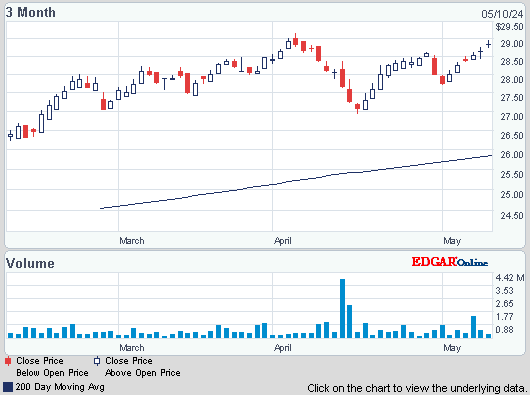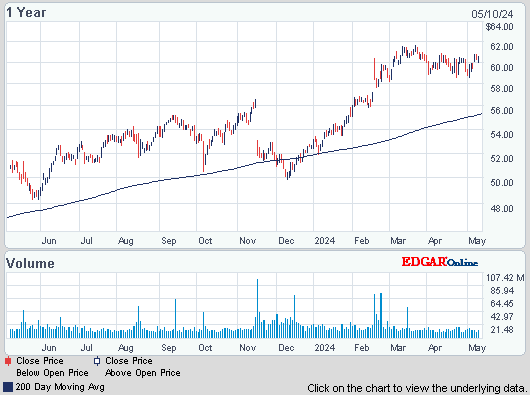Dow plunged 212, decliners over advancers 7-1 & NAZ sank 59. The MLP index was flattish in the 439s & the REIT index lost another 5+ to the 265s (down 50 from its peak). Junk bond funds were weak & Treasuries also sold off. Oil did little, helped by MidEast troubles, & gold fell back on profit taking.
AMJ (Alerian MLP Index tracking fund)


Photo: Yahoo
The number of Americans seeking unemployment benefits dropped 15K last week to 320K the fewest since Oct 2007 — a sign of dwindling layoffs & steady if modest job growth. The Labor Dept said that the 4-week average fell 4K to 332K, the fewest since Nov 2007 & the 5th straight decline. Companies are laying off fewer workers, a trend that has lowered applications for unemployment benefits 14% this year. But hiring is still sluggish, resulting in only modest net job growth. Nearly 4.6M received unemployment benefits, about 66K more than in the previous week but nearly 20% less than a year ago. Layoffs have averaged 1.6M a month thru Jun, fewer than the monthly average of nearly 1.8M in the pre-recession year 2006. Hiring hasn't recovered as quickly. Employers hired an average of 4.3M a month this year thru Jun, well below the 2006 monthly average of 5.3M. As a result, net job growth is still subpar. And many jobs are for part time work.
Jobless Claims in U.S. Decline to Lowest Level Since 2007

Photo: Bloomberg
Output at US factories declined slightly in Jul, reflecting a drop in auto production. But the decline was expected to be temporary given the banner sales year automakers are having. Manufacturing output edged down 0.1% in Jul compared with Jun, the Federal Reserve (FED) reported, the first drop since declines in Mar & Apr. The weakness reflected a 1.7% fall in the output of motor vehicles & parts. That decline should be reversed in coming months as automakers ramp up production for the new model year. Overall industrial production, which includes factories, mines and utilities, was flat in Jul after a 0.2% rise in June. A sharp 2.1% surge in mining was offset by a 2.1% drop in utility output. Output in manufacturing, the most critical component of industrial production, is up a modest 1.3% from the level of a year ago. The output of construction supplies, & defense & space equipment showed gains. But production of business equipment was unchanged, & the output of information processing equipment fell. This report was weaker than an earlier report from the Institute for Supply Management (ISM) that showed US factories hired more workers & received a surge of new orders in Jul. That activity helped push the ISM manufacturing index to a reading of 55.4 in Jul, the highest point in 2 years & up from 50.9 in Jun.
Industrial Production in U.S. Was Unchanged in July, Fed Says

Photo: Yahoo
Wal-Mart, a Dow stock & Dividend Aristocrat, cut its annual profit forecast after higher payroll taxes reduced customer traffic in Q2. EPS will be $5.10 -$5.30 WMT said, less than its earlier projection of $5.20 -$5.40. The estimate called for EPS of $5.29. CEO Mike Davis has been advertising low prices & improving grocery offerings to draw US shoppers coping with elevated unemployment & higher taxes. Sales at US stores open at least 12 months excluding fuel fell 0.3% in Q2. Analysts estimated a 0.9% gain. Q2 EPS was $1.24 a share versus $1.18, a year earlier. The estimate was for $1.25. The results included a charge of 1¢ for a tax matter. Revenue rose 2.3% to $116.9B, trailing the $118.5B estimate. That marks the 5th straight qtr that company sales have missed projections. “The 2 percent payroll tax increase continues to impact our customer,” Bill Simon, US CEO, said. The company also expected sales to be helped by rising grocery prices, which didn’t occur in a “meaningful way.” Q3 EPS will be $1.11-$1.16, less than the projection of $1.17. To try to keep shoppers coming into stores, WMT has introduced a major advertising push promoting its low prices & has been reminding customers that it offers full refunds on fruits & vegetables, & sending auditors on weekly store checks to monitor its groceries’ quality. The stock pulled back 2.01.
Wal-Mart Cuts Profit Forecast as Higher Taxes Damp Sales

Dow fell to its lowest in a month on worries about how long the FED will keep its stimulus going. Nobody knows, but time is measured in months, not years. It could even be measured in weeks. Selling has hit REITs very hard on concerns that higher interest rates will pinch profits. They will, but REITs have prospered in the past when interest rates were higher. The MLP index is off 30 from its record high earlier this year on the same worries. Until the FED speaks, markets will be under pressure.
Dow Jones Industrials

AMJ (Alerian MLP Index tracking fund)
Treasury yields:
U.S. 3-month |
0.05% | |
U.S. 2-year |
0.35% | |
U.S. 10-year |
2.80% |
| CLU13.NYM | ....Crude Oil Sep 13 | ...107.25 | (0.4%) |
| GCQ13.CMX | ...Gold Aug 13 | .......1,327.70 | (0.5%) |

Photo: Yahoo
The number of Americans seeking unemployment benefits dropped 15K last week to 320K the fewest since Oct 2007 — a sign of dwindling layoffs & steady if modest job growth. The Labor Dept said that the 4-week average fell 4K to 332K, the fewest since Nov 2007 & the 5th straight decline. Companies are laying off fewer workers, a trend that has lowered applications for unemployment benefits 14% this year. But hiring is still sluggish, resulting in only modest net job growth. Nearly 4.6M received unemployment benefits, about 66K more than in the previous week but nearly 20% less than a year ago. Layoffs have averaged 1.6M a month thru Jun, fewer than the monthly average of nearly 1.8M in the pre-recession year 2006. Hiring hasn't recovered as quickly. Employers hired an average of 4.3M a month this year thru Jun, well below the 2006 monthly average of 5.3M. As a result, net job growth is still subpar. And many jobs are for part time work.
Jobless Claims in U.S. Decline to Lowest Level Since 2007

Photo: Bloomberg
Output at US factories declined slightly in Jul, reflecting a drop in auto production. But the decline was expected to be temporary given the banner sales year automakers are having. Manufacturing output edged down 0.1% in Jul compared with Jun, the Federal Reserve (FED) reported, the first drop since declines in Mar & Apr. The weakness reflected a 1.7% fall in the output of motor vehicles & parts. That decline should be reversed in coming months as automakers ramp up production for the new model year. Overall industrial production, which includes factories, mines and utilities, was flat in Jul after a 0.2% rise in June. A sharp 2.1% surge in mining was offset by a 2.1% drop in utility output. Output in manufacturing, the most critical component of industrial production, is up a modest 1.3% from the level of a year ago. The output of construction supplies, & defense & space equipment showed gains. But production of business equipment was unchanged, & the output of information processing equipment fell. This report was weaker than an earlier report from the Institute for Supply Management (ISM) that showed US factories hired more workers & received a surge of new orders in Jul. That activity helped push the ISM manufacturing index to a reading of 55.4 in Jul, the highest point in 2 years & up from 50.9 in Jun.
Industrial Production in U.S. Was Unchanged in July, Fed Says

Photo: Yahoo
Wal-Mart, a Dow stock & Dividend Aristocrat, cut its annual profit forecast after higher payroll taxes reduced customer traffic in Q2. EPS will be $5.10 -$5.30 WMT said, less than its earlier projection of $5.20 -$5.40. The estimate called for EPS of $5.29. CEO Mike Davis has been advertising low prices & improving grocery offerings to draw US shoppers coping with elevated unemployment & higher taxes. Sales at US stores open at least 12 months excluding fuel fell 0.3% in Q2. Analysts estimated a 0.9% gain. Q2 EPS was $1.24 a share versus $1.18, a year earlier. The estimate was for $1.25. The results included a charge of 1¢ for a tax matter. Revenue rose 2.3% to $116.9B, trailing the $118.5B estimate. That marks the 5th straight qtr that company sales have missed projections. “The 2 percent payroll tax increase continues to impact our customer,” Bill Simon, US CEO, said. The company also expected sales to be helped by rising grocery prices, which didn’t occur in a “meaningful way.” Q3 EPS will be $1.11-$1.16, less than the projection of $1.17. To try to keep shoppers coming into stores, WMT has introduced a major advertising push promoting its low prices & has been reminding customers that it offers full refunds on fruits & vegetables, & sending auditors on weekly store checks to monitor its groceries’ quality. The stock pulled back 2.01.
Wal-Mart Cuts Profit Forecast as Higher Taxes Damp Sales
Wal-Mart (WMT)
Dow fell to its lowest in a month on worries about how long the FED will keep its stimulus going. Nobody knows, but time is measured in months, not years. It could even be measured in weeks. Selling has hit REITs very hard on concerns that higher interest rates will pinch profits. They will, but REITs have prospered in the past when interest rates were higher. The MLP index is off 30 from its record high earlier this year on the same worries. Until the FED speaks, markets will be under pressure.
Dow Jones Industrials










No comments:
Post a Comment